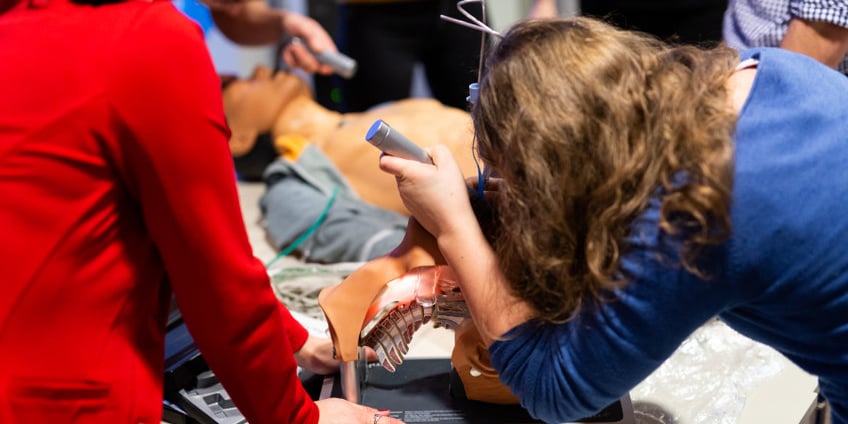
It’s important to regularly reevaluate your team’s knowledge of common bleeding disorders, their symptoms, and the unique challenges they present for EMS personnel during airway suctioning and treatment.
According to the National Hemophilia Foundation, around 33,000 people are living with hemophilia — the most common bleeding disorder — in the United States. Although these conditions are somewhat rare, EMS must be familiar with these disorders, so they know what to look for when responding to certain traumatic injuries and patient conditions.
What are bleeding disorders?
Bleeding disorders are a group of disorders that result in the inability to form a proper blood clot. The body naturally produces 13 clotting factors, and a defect of any of these factors can result in mild, moderate, or severe bleeding conditions. Some disorders are inherited or acquired, such as hemophilia, while others stem from conditions like anemia, cirrhosis of the liver, HIV, leukemia, and vitamin K deficiency, or from the use of certain blood-thinning medications such as aspirin, heparin, and warfarin.
Bleeding disorders can impact individuals of all ages, from newborn babies to the advanced aged. Hemophilia, the most common hereditary bleeding disorder, occurs when blood lacks sufficient clotting factors or proteins. The most common inherited bleeding disorder, von Willebrand disease (VWD), is caused by defects in a blood substance that helps with clot formation.
Symptoms
The symptoms of a bleeding disorder include:
- Blood in the urine or stool
- Excessive bleeding that does not stop with pressure and may start spontaneously, particularly with nosebleeds, or after a cut, dental procedure, or surgery.
- Bruising often and having large bruises.
- Heavy bleeding after childbirth
- Heavy menstrual bleeding, including having periods that often last longer than seven days or require changing sanitary pads or tampons more each hour
- Petechiae, or bleeding under the skin causing tiny purple, red, or brown spots
- Redness, swelling, stiffness, or pain from bleeding into muscles or joints – this is particularly common with inherited hemophilia
- Umbilical stump bleeding that lasts longer than what is typical for newborns (about 1 to 2 weeks after the cord is cut) or that does not stop.
How bleeding disorders affect treatment and suctioning
A patient’s bleeding may not always be a cause for panic, but when it comes to bleeding disorders resulting from traumatic injuries, they can cause continuous bleeding into the airway, leading to aspiration and contamination of the airway. Blood in the airway is one of the most significant predictors of intubation failure and mortality, and clotted blood in the lower airway can present clinicians with life-threatening airway obstruction or pulmonary collapse. Therefore, blood clots should always be considered as causes of obstruction, especially if clots are identified after coughing or suctioning.
While it may seem tempting to remove any blood clots as soon as they’re spotted, in some cases, the suctioning of smaller clots may cause re-bleeding if the clots originate in the lower airway. Larger clots must be removed from the airway since they can produce life-threatening airway obstruction and secondary complications in the lungs.
Applying the SALAD Technique
One of the most reliable techniques for suctioning blood in the airway is the SALAD Technique (Suction Assisted Laryngoscopy and Airway Decontamination), which involves aggressive suctioning to quickly clear the airway, allowing for the intubation of a patient.
There are several benefits that this method provides for first responders treating patients with blood disorders. For one, the catheter can be left in place during intubation, providing an easy route for removing blood and other contaminants. This technique also provides easy access to the trachea, even when patients are continuously bleeding.
The steps for implementing the SALAD Technique safely and effectively are as follows:
- Use a rigid suction catheter, such as the SSCOR SDC Catheter™ (Formerly the SSCOR DuCanto Catheter®), which was specifically designed for this technique.
- During continuous suctioning, insert a laryngoscope blade while shifting the catheter to the corner of the patient’s mouth and to the left of the blade.
- Position the tip of the catheter at the patient’s esophagus, allowing for continual suctioning while visualizing the vocal cords.
- Intubate the patient, suctioning the endotracheal tube before commencing ventilation.
- Clear the catheter of blood and other fluids once the patient is intubated.
Practicing proper techniques and procedures for treating patients with bleeding disorders is critical for all EMS teams. Without appropriate preparation and knowledge of these disorders and their symptoms, you’ll be unsuccessful when it comes time to intubate certain patients, resulting in airway obstruction and a host of other dangerous complications.
Editor's Note: This blog was originally published in March, 2022. It has been re-published with additional up to date content.















